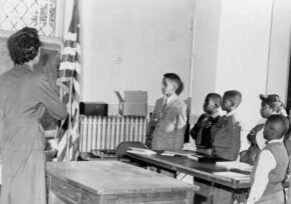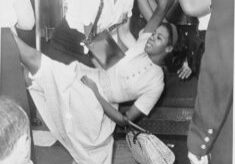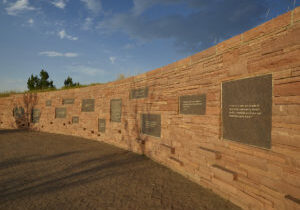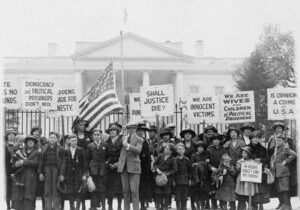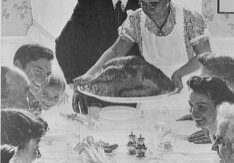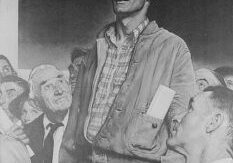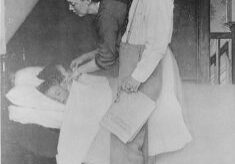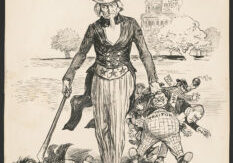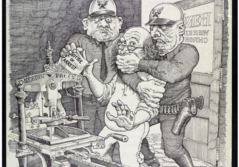Lesson Plans
Congress and Child Labor
Students analyze primary source images and posters to explore why Congress decided long ago that it was important to pass labor laws to protect children, then apply what they have learned by creating their own historical poster. After, students could investigate child labor today or another contemporary issue related to children and make connections by creating a poster to raise awareness of the issue.
Capture the Flag
Students investigate primary sources to explore the various ways people use the United States flag to show characteristics such as pride, loyalty, and unity for the nation, then create a collage showing examples of celebration and remembrance. After, students can make connections by creating a collage, drawing, poem, video, etc., that shows how the flag makes them feel.
Civil Rights and Civic Action
Students deepen their understanding and personal integration of the concept of commitment to civic service by examining the historic contribution of young people in shaping positive changes in America using primary sources from the Library of Congress. Students explore the civic service accomplishments of young people to help bring about social change and identify the potential of young people in creating positive change through civic service. Students then identify characteristics of civic activists as well as current problems or causes about which they are passionate and draft an action plan to affect change.
Gun Violence and Next-Generation Coalitions
Students deepen understanding of civic action through a focus on the empowerment that citizens gain through building coalitions through an exploration of the accomplishments of young people to help bring about changes through civic action. Referencing Library of Congress resources and sources of the Columbine school shooting, students identify the potential of young people in creating positive change through civic action. Students then examine current problems or causes about which they are passionate and draft an action plan.
Kids, Collaboration, and Coalitions
Students develop their personal understanding of their membership in a civic community by examining the historic contribution of young people in shaping positive changes in America using primary sources from the Library of Congress and other sources. Students explore coalition-building accomplishments of young people recognizing that any individual, regardless of age, race, status, or gender has the potential to help bring about changes through working together. Students then identify characteristics of collaboration and creating coalitions in order to build their understanding of civic community.
Speaking Out: Four Freedoms Then and Now
Students analyze a part of Franklin Delano Roosevelt’s “Four Freedoms” speech and use primary sources from the Library of Congress to gain historical context. Next, students explore sources from the Library to draw conclusions about the impact of the speech on American culture at the time. Students then write their own “Four Freedoms” speech, outlining four freedoms they believe Americans should keep front-of-mind today.
Securing Our Freedoms Beyond the Bill of Rights
Students analyze primary sources from the Library of Congress including Norman Rockwell’s “Four Freedoms” and “The Bill of Rights” to the U.S. Constitution. Students then identify amendments related to two of the four freedoms from the primary sources and then work in small groups to reach consensus and propose a new amendment to secure rights or freedoms not included in the Bill of Rights.
Find Your Freedom Beyond the Bill of Rights
Students analyze primary sources from the Library of Congress to identify freedoms, then review background information about the Bill of Rights to the U.S. Constitution. Next, students match the amendments related to some of the freedoms they identified through analyzing sources and then work in small groups to reach consensus and propose a new amendment to secure freedoms not included in the Bill of Rights.
Espionage, Sedition, Censorship, and Speaking Up
Students analyze a political cartoon created by William Allen Rogers during World War I to give context to press censorship during that war. Next, students explore additional sources from the Library of Congress to analyze how censorship worked both before and after the passage of the Espionage and Sedition Acts of 1917-18. Finally, students compose their own “email to the editor” of a local newspaper or online news source, expressing their own views about the importance of freedom of the press and their informed opinion of press censorship in wartime.
Freedom of the Press, Censorship, and Sedition
Students explore freedom of the press as they examine sources related to government censorship of the press. After reviewing the First Amendment and the Sedition Act of 1798, students examine a political cartoon to discuss the relevance of freedom of the press over time. Finally, students design and create their own poster promoting freedom of the press today.

